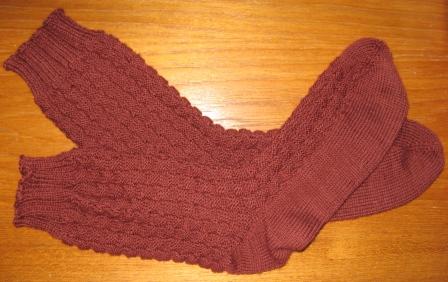 (This is the second in a series of posts discussing the process of designing DH’s basketweave socks.)
(This is the second in a series of posts discussing the process of designing DH’s basketweave socks.)
We left off Part 1 with a completed toe, and have discovered that in order to have a sock foot that is about 7" circumference, we have ended up with 64 sts total for the foot of the sock.
Part 2 starts with the patterning of the foot. But wait! One more little detail.
I don’t always remember to do this, and I actually don’t think I did it on these particular socks — but if you have a tendency to wear out the toes, as my DH does, it will make it a lot easier to remove and replace the toe later if you throw in a couple of rounds of plain stockinette here. No increases, no pattern, just a round or two of plain ol’ knit all sts. Cheap insurance.
Step 3 is to set up the pattern for the instep, which is the technical term for "the part of the sock that’s on the top of your foot." This can be the make-or-break part of the whole thing, because as you can see from the finished socks, the flow of the pattern for the entire sock is going to be established right here.
The sole sts — which traditionally means half of the total number of sts — are going to stay in plain stockinette. Therefore, we have 32 sts for the sole that are going to remain in plain stock, and 32 other sts over which to work our st pattern.
As mentioned before, the st pattern I was planning to use was a 4 x 4 basketweave. With a repeating pattern of (4 knits, 4 purls), that means a full pattern repeat is 8 sts, and 8 rows. Here is a graphical version, with a single repeat picked out in red:
- KKKK PPPP KKKK PPPP KKKK PPPP KKKK PPPP
- KKKK PPPP KKKK PPPP KKKK PPPP KKKK PPPP
- KKKK PPPP KKKK PPPP KKKK PPPP KKKK PPPP
- KKKK PPPP KKKK PPPP KKKK PPPP KKKK PPPP
- PPPP KKKK PPPP KKKK PPPP KKKK PPPP KKKK
- PPPP KKKK PPPP KKKK PPPP KKKK PPPP KKKK
- PPPP KKKK PPPP KKKK PPPP KKKK PPPP KKKK
- PPPP KKKK PPPP KKKK PPPP KKKK PPPP KKKK
Obviously, that 8-st multiple divides quite nicely into the 32 sts I have available — but actually, what’s even more important is that it divides nicely into the 64 sts total that will be on the leg of the sock, where I will want the pattern to flow smoothly all around, with no hiccups. This is a fairly important rule of standard sock design: Having the pattern fit nicely on the leg of the sock trumps just about any juggling that you might have to do on the instep.
But this time, there’s no need to finagle with either number of sts. Whoo-hoo! We’re off to the races, right?
Well, not quite. It might be tempting to just start right in with [K4, P4] over the instep and then K all the way across the sole. Easy, but not aesthetic: if I do that, the st pattern will not be centered over the 32 instep sts. What I will have on the instep after the first round is this — if you imagine working 32 sts, starting over on the right with knitting 4 sts:
PPPP KKKK PPPP KKKK || PPPP KKKK PPPP KKKK
Notice this is not laterally symmetrical – the left half is not a mirror image of the right half. The double red line that represents the middle of my 32 sts has knits on one side and purls on the other. The whole thing has knits at the beginning, and purls at the end. That is not what we want, my friends.
(Notice also that I only need to use the first round to set it up, because the whole basketweave pattern is symmetrical about the same line. Subsequent rounds will either be the same as this one, or will be flipped so that K’s turn into P’s and vice versa. But the symmetry will stay the same.)
I’m sure there are proper names for some of the concepts here, but I don’t know them. What I do know is, it all has to do with the number of sts in your st pattern, and the number of repeats involved.
For example: if I had 36 sts on the instep of my sock, I could start off with K4 just fine. I would then have:
KKKK PPPP KKKK PPPP KK || KK PPPP KKKK PPPP KKKK
which is laterally symmetrical. There are two knits on either side of the double red line, and knits on either end of the whole thing.
What’s the difference? The double red line that denotes the center of my 36 sts now falls in the middle of a knit block, which also happens to be the middle of my pattern stitch!
The centering process goes like this: First, find the center of your stitch pattern — the place where you can "fold it in half" to make a mirror image — i.e. the point about which it has lateral symmetry. Then, line that point up with the center of your instep sts by counting out from the center, in order to figure out where in the sequence to start your pattern st.
In this case, the center of the st pattern is in the middle of the 4 knit sts. As long as I have half my instep sts on either side of that line, I will have lateral symmetry.
Since I already have my st pattern written out, all I have to do is count 16 sts to the left and to the right to get my 32 instep sts, and voilà!
It’s often quickest and easiest to work this out on paper: exactly like what I did here, writing out K’s and P’s (or whatever) until you can pinpoint the center of the st pattern. (You can use a spreadsheet too, and copy and paste, if you prefer.) Write out more repeats than you need for the number of sts that you have — mark the center of the pattern — and then it’s a simple matter to count sts and "chop off" the extras on either end.
Using the same example, then, I might end up with something like this:
KKKK PPPP KKKK PPPP KK || KK PPPP KKKK PPPP KKKK
where I have now crossed off 2 extra sts on either end, and we can see that if I want my 4 x 4 basketweave to be centered over 32 sts, I’ll have to start off with a K2 and then go into my P4.
Hey, that wasn’t so bad, was it? Makes a lot of sense when you look at it graphically, right?
But if I were to write it out, my sock "pattern" looks like this for the foot:
- Rounds 1 – 4: K2, ** P4, K4 ** 3 times, P4, K34. (that’s the 2 K’s on the end of the instep, plus the 32 sts on the sole.)
- Rounds 5 – 8: P2, ** K4, P4 ** 3 times, K4, P2, K32.
- Repeat these 8 rounds for pattern.
You can see that all that sensible graphical stuff doesn’t translate all that well into words. Even worse, if I were to try to write it out for two different sizes — say, my DH’s 64-st sock, and another, larger, 72-st sock — using the 36-st example as my model for the second size — I end up with THIS:
- Rounds 1 – 4: K (2,4) ** P4, K4 ** 3 times, P4, K(34, 40).
- Rounds 5 – 8: P (2,4) ** K4, P4 ** 3 times, K4, P(2,4), K(32,36).
- Repeat these 8 rounds for pattern.
And again, the whole visual aspect of what I did above is completely lost in the translation.
Essentially this idea of "centering" is a fairly simple concept, once you "get it". But it’s really kind of hard to write it out as a step-by-step explanation. Imagine how complicated and wordy this post would be if I didn’t have those little visuals!
OK, that part of the sock should keep you busy knitting for a while. I did about 10 pattern repeats, or 80 rounds, to get to the heel on DH’s socks. Of course, your DH’s feet may be different.
(I know I shouldn’t do this, but I can’t help it: 80 rounds x 64 sts per round = 5,120 sts. AAAH! And that’s only half of one sock, not even counting the toe sts!)
In Part 3, I’ll digress a little bit from this particular sock, and discuss some of the other situations that can arise when trying to center stitch patterns on socks.
